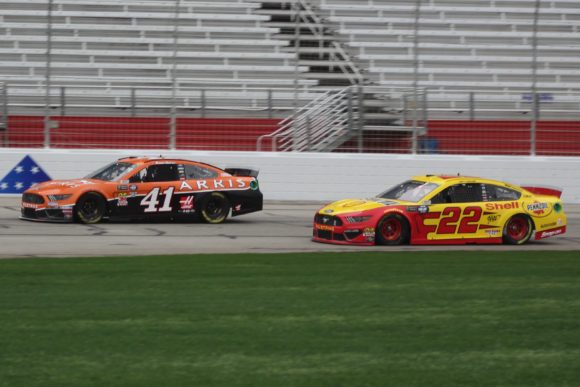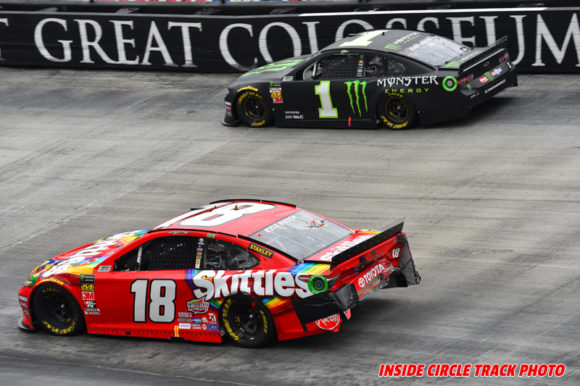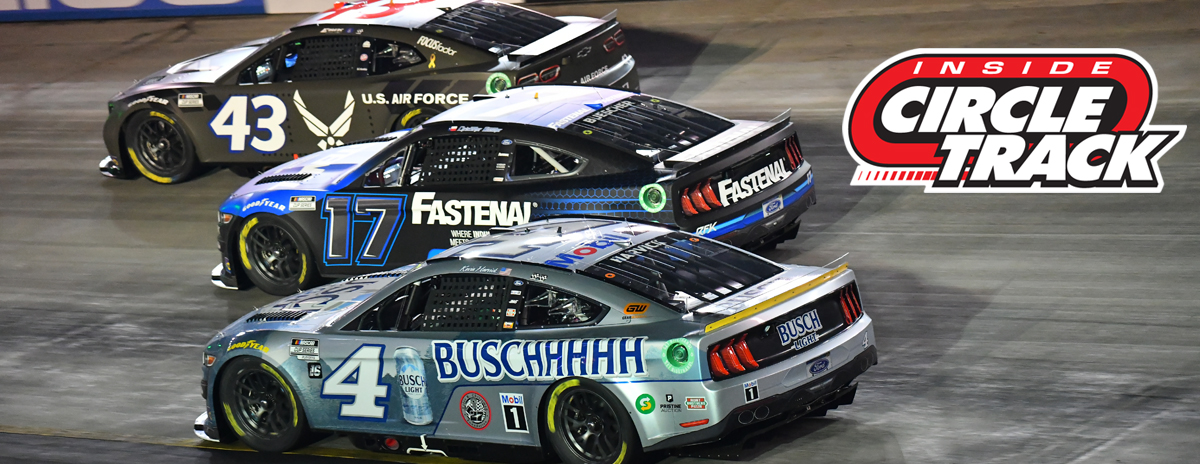
*Turn 2 Blog is a regular feature on InsideCircleTrack.com. Here, site operators Michael Moats and Richard Allen take turns offering their thoughts on the NASCAR and pavement short track racing topics of the day.
Richard: There was much talk and speculation coming into the 2019 Monster Energy NASCAR Cup Series season regarding the implementation of a new package teams would have to use on the race cars. Horsepower limitations and various aerodynamic adjustments were mandated by NASCAR with the hope that the on-track product would be improved. And while those at the top of the sanctioning body might not say it expressly, one of the specific aims of those changes was to create more excitement on the so-called ‘cookie cutter’ tracks measuring 1.5 miles to 2 miles in length.
Taking the last two 1.5-mile races into consideration, it might be safe to say that the new package is at least beginning to produce what it was hoped it would produce. The Digital Ally 400 at Kansas Speedway was a highly entertaining race with Brad Keselowski making a late pass on Alex Bowman to secure the win. Differing pit strategies and the fact that Kevin Harvick, who appeared to have the race’s dominant car, found himself mired in the middle of the pack for much of the race’s second half certainly helped improve the overall show. But still, it was one of the better races on this type of track in some time.
And then there’s the case of Saturday night’s Monster Energy NASCAR All-Star race. That event had just about everything a fan could want from a race. Exciting on-track action, a popular winner, and even a little post-race drama were all part of the action at Charlotte Motor Speedway.
Granted, as has been the case in the past, NASCAR used the All-Star Race as somewhat of a testing ground for some new ideas as even more aerodynamic adjustments were implemented on the cars. Still, much of the same package used in the other races were also in place on Saturday night.
With all that said, can the conclusion be reached that NASCAR has taken the right steps toward solving its mile-and-a-half “problem”?

The new aero package used by NASCAR seems to have improved the racing on .5-mile tracks
Michael: I think it’s still a bit too early to claim success or failure for this new package. A number of media members are already proclaiming it as a success based on the last two races. While those were highly entertaining and competitive, we need to see how this package fairs on tracks not known for a lot of competitiveness such as Michigan or Loudon.
I think this package, for tracks like Dover and even Bristol, needs some adjusting. Both tracks saw tremendous corner speeds, especially at Dover. I was skeptical, overall, when this rules package was announced but it’s starting to grow on me.
Richard: Your mention of Dover and Bristol is an important point. While the racing at the last two 1.5-mile tracks has been entertaining, the tracks measuring 1-mile or less have not been as thrilling. While Bristol was a pretty good race overall, the recent races at Martinsville, Richmond and Dover saw little passing, particularly at the very front of the field.
Many drivers are reporting that the cars have so much down force that they are “too easy” to drive. And with the cars so firmly planted to the racing surface, there are few slips and even fewer opportunities to pass. As a result, long stretches of races on the shorter tracks are seeing drivers take the lead and keep it.
In years past, the 1.5-mile tracks saw little passing while short tracks and road courses grew in popularity because of the mixing of positions that typically took place in those races.
It’s almost as if the new aero package has reversed the roles of those two types of tracks, isn’t it?

Has short track racing been hampered by the new aero package?
Michael: Yes it seems that way, at least to a point. I recall the Atlanta race being somewhat competitive. But with the cars having so much down force, we didn’t see the cars get sideways that much once the tires had a lot of wear on them, unlike in previous years. I think that was one thing that took away from the enjoyment of that particular race.
Overall, we don’t see cars looking as much out of control as we used to see them. That has led to less cautions in many races. At some of these races, the restarts were the most exciting part of the race. The fans have certainly noticed the lack of cautions this year.
Richard: The whole thing is an ever-evolving process. The new Gen 7 car that to some degree was debuted in the All-Star Race is one example of that. Hopefully NASCAR can find a happy balance that will allow for competitive racing not only on the 1.5-mile tracks as well as the short-tracks, road courses and big super speedways.
Michael: I do like the fact that NASCAR has found a way to get rid of the restrictor plates for Daytona and Talladega. The Talladega race was exciting and appeared to have given the drivers some throttle response lacking with the plates. But yes, more tweaks are needed to make this package good for all tracks.
Respond to this post on Twitter by following @RichardAllenIDR and @MichaelRMoats or by liking the InsideCircleTrack.com Facebook page.
Also, dirt racing fans can check out InsideDirtRacing.com for more racing content.
